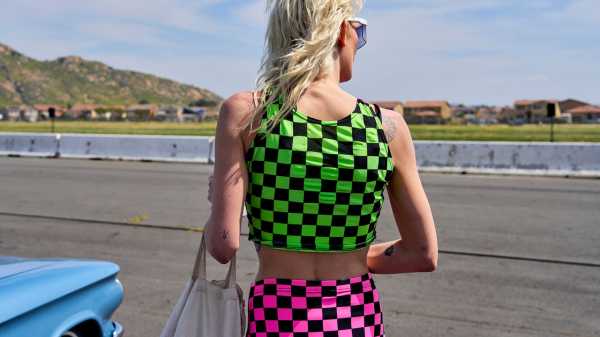
Save this storySave this storySave this storySave this story
Sitting in the shade from palm trees at Flabob Airport, in Rubidoux, California, in mid-April, Diana Branch, fifty, was letting the engine on her 1929 Ford Model A roadster, nicknamed Honey Dew, cool between races. Wearing checkered Vans shoes, with pink Kinesio tape in stripes on her right ankle for a recent injury, Diana had raced all day Saturday, grudge matches on the one-eighth-mile drag strip set up on the runway, fun matches against casual challengers. But this was Sunday, and, at noon, single-elimination heats were starting in the Race of Gentlemen, featuring drivers and vintage cars from all over the world. Diana had her race face on. And she was hoping she didn’t have to go up against her husband, Tom.
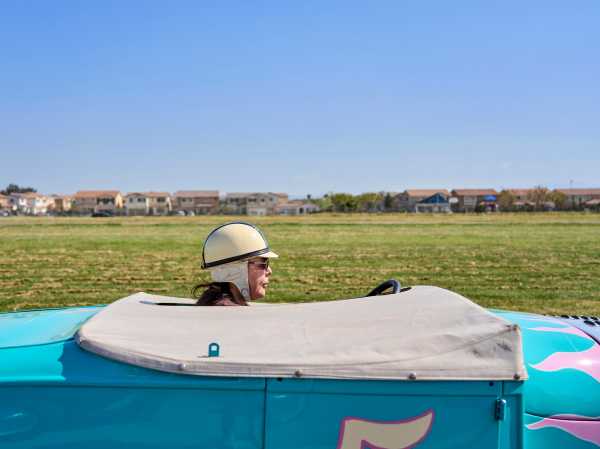
Diana Branch waits to race her 1929 Ford roadster.
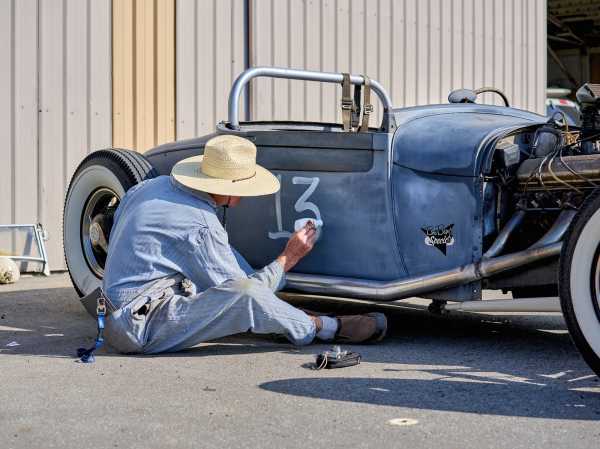
A driver writes his race number on his car.
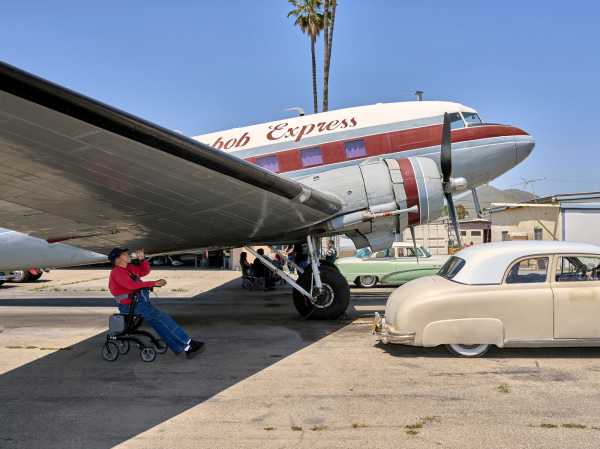
A spectator at the Race of Gentlemen sits in the shade of an airplane wing.
Diana was born in Matatán, Mexico, and came with her family to California when she was six. In El Sereno, a community at the edge of L.A., her father was an electrician, but he always worked on vintage cars. “I was learning my language when I was nine, watching classic hot-rod movies with my dad in the garage. I’d go to school and say ‘copacetic’ or call somebody ‘daddy-o.’ My second-grade teacher said I was an old soul,” she said, laughing. In summer, the family would go back to Sinaloa to help on the ranch. Diana rode horses bareback when she was small, and learned to drive a ranch truck as a child. “In California, my mom would leave the keys in the car at the store, and when she came back we’d be parked in a different place. I was ten, and I just had to drive.”
She and Tom met when they were sixteen, juniors at rival L.A. high schools, but working together at a restaurant in Alhambra. Dating for three years, Diana and Tom went to nostalgia drag-race meets like the Antique Nationals, in Palmdale, California. They married in 1992, at nineteen, and bought their first car together—a 1955 Studebaker—making hundred-dollar monthly payments to Tom’s boss. They’ve been building engines and racing ever since, out of their house in San Gabriel. By 2008, she was racing her 1942 Ford sedan at the Antique Nationals; she beat everyone in her class, and, when the man handing her the award said, “I didn’t know we had trophy girls,” Diana said, “I’m here to collect my trophy, for winning my class.”
Their son, Tomas, twenty-eight, was helping in the pit on Sunday. Their daughter, Dalia, had turned twelve the day before the races. She’s worked on the cars, too—changed tires earlier that day. People say they have racing in their blood, but Dalia’s story is singular. In 2010, Diana drove ten hours to the Bonneville Salt Flats, constantly hungry though her race suit fit unusually tight. She earned a land-speed record—unaware she was pregnant with Dalia. “Our initials are the same in the record book,” she said.
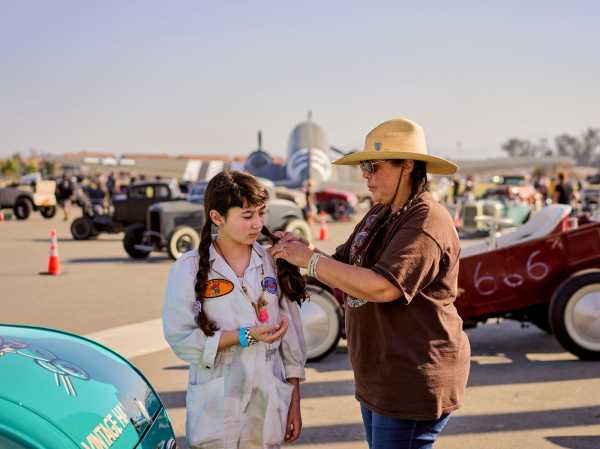
Diana Branch braids the hair of her daughter, Dalia, at Flabob Airport.
The sounds of powerful engines began to rip and stutter through the sky as drivers moved their cars into the lineup along the runway. Mel Stultz watched, barefoot, a bemused grin on his face. Stultz, a member of the Oilers Car and Motorcycle Club, which co-founded the National Hot Rod Association back in 1951, started running the Race of Gentlemen, in 2012. He had grown bored with traditional classic-car shows, with vehicles parked and admired. “I wanted to create a moving history of cars,” he said. His inaugural drag race, on the beach at Asbury Park, New Jersey, was a huge success, just days before Hurricane Sandy made landfall. Near home base in Wildwood, New Jersey, TROG’s annual September Hot Rod Races attract up to twenty-five thousand people.
In 2016 and 2019, TROG held events in Pismo Beach and Santa Barbara, California, but December, 2022, was the first time the event came to historic Flabob Airport, near the Santa Ana River, lined with sycamore and willow trees, and Mt. Rubidoux, covered in swaths of yellow wildflowers. Antique biplanes and historic aircraft were parked along the tarmac.
This is old-school heaven. I came in December with my ex-husband, Dwayne Sims. We’ve loved cars since high school, too. We met as freshmen. I was fourteen, he was fifteen, and we had no car for a date. In 1976, his father bought a 1961 Cadillac with fins, primer brown, a bullet hole in the passenger window from the recent demise of the former owner, and Dwayne finally picked me up. At that first Flabob race, we stayed all day, and saw our favorite drivers: Diana Branch in Honey Dew, and Sherry Martin, out of San Bernardino, with a lavender jalopy sporting a bamboo roof. Diana and Sherry kept winning their heats going away, and as Robert Ruiz, Sherry’s husband, said, grinning, “It’s the Race of Gentlemen, but the women were kicking ass.”
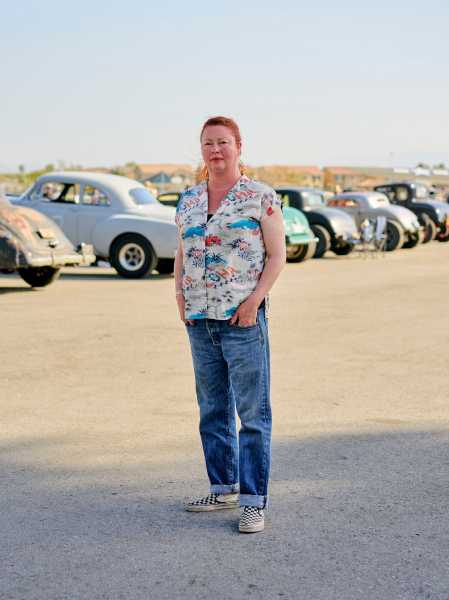
Sherry Martin poses near her 1927 Ford two-door sedan.
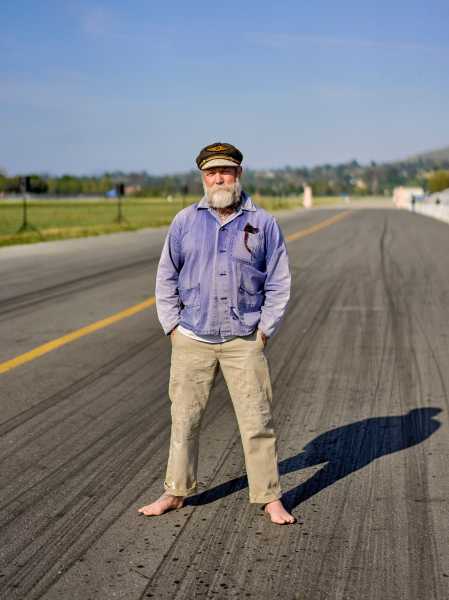
Mel Stultz, the founder of the Race of Gentlemen, stands at Flabob Airport.
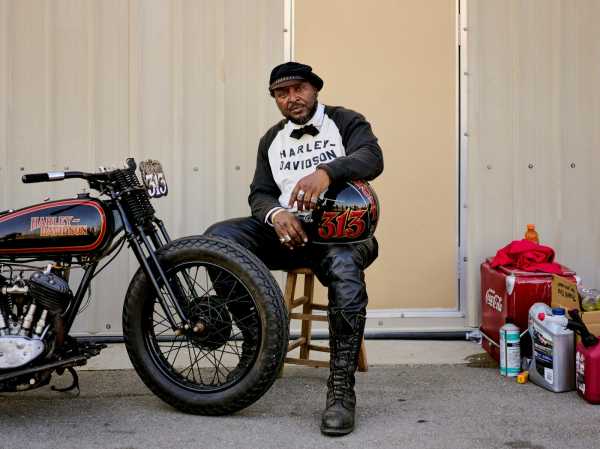
Randy (Detroit) Hayward sits alongside his 1929 Harley-Davidson DL at Flabob Airport.
On Sunday, Sherry, forty-four, and Robert, forty-five, were set up behind their vehicles. They met at Fontana High in 1994, when Sherry was a freshman, Robert a junior. He sold her a 1963 Corvair for three hundred dollars—money she received as a bequest from her grandfather. They married at nineteen, and started racing, eventually buying a house in San Bernardino where they work on their cars together in the garage. Sherry drives a lavender 1927 Ford two-door sedan, with its steering wheel on the right, a Chevy 283 motor, and a 1957 Chevy Positraction rear end. (Positraction distributes weight to each rear tire—if one is slipping, power is transferred to the other wheel for grip.) Robert drives a 1925 Model T roadster-pickup truck, highly modified, with a Chevy 327 dual-quad motor for speed, and a 1957 Corvette Positraction rear end.
These cars are labors of love and years for drivers like Diana and Tom, Sherry and Robert, with vehicles built in their garages or yards or driveways. Many of them know one another from other drag strips—John Martinez, known as Riverside Johnny, in his 1927 banger, and Louis Stands, a.k.a. Hothead Lou, from Orange County, in his green roadster, Verde 32.
Also racing on Sunday was Casey McWilliams in the Chico Nacho, built by his friend Charlie Hascall and five high-school students in Dayton, Oregon—they made the long journey to Rubidoux hoping for a win. Vintage Harley-Davidson and Indian motorcycles were lined up for heats as well—Randy (Detroit) Hayward, a former high-school principal, brought his 1929 Harley from his namesake native city.
Other cars are sponsored, with parts from investors. “We’ll go up against anybody,” Sherry said. “It doesn’t matter if they have sponsorships and plenty of money—everyone has a chance. Even the little guys.”
Diana said, “We hope they mess up and miss a shift, or their tires don’t stick. That’s all it takes.”

Layla, a four-month-old spectator, wears hearing protection at Flabob Airport.
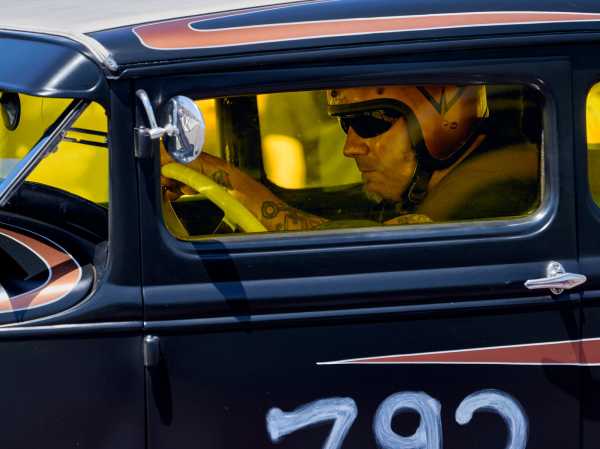
A driver waits at the starting line of a race.
Tom and Diana won their first heats, but she was knocked out by Hothead Lou. Tom made it another round, before being eliminated. Robert and Sherry each won their first two heats, but then came down the lineup for the quarterfinals, and they were pitted against each other.
All the racers and crews were lined up, watching intently, as they got an even start, tires laying rubber on the heated asphalt, but Robert won by two feet at the finish. Sherry parked her vehicle, drank some water, put on her straw hat, and went to help her husband in the lineup for the semifinals.
Robert raced against another opponent, but the ruling was a jump start, so they were told to go again, but Robert’s engine was running too hot. He said, “I just ran! It’s gotta cool down!” Vintage hot rods have to be handled with care—a break was called so the cars could recover.
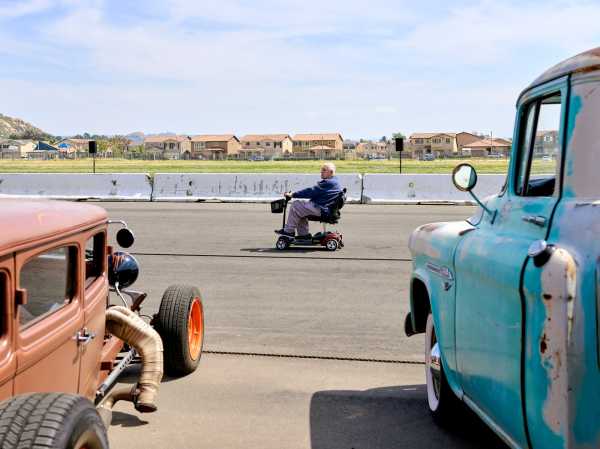
A man appraises vintage cars on display, at Flabob Airport.
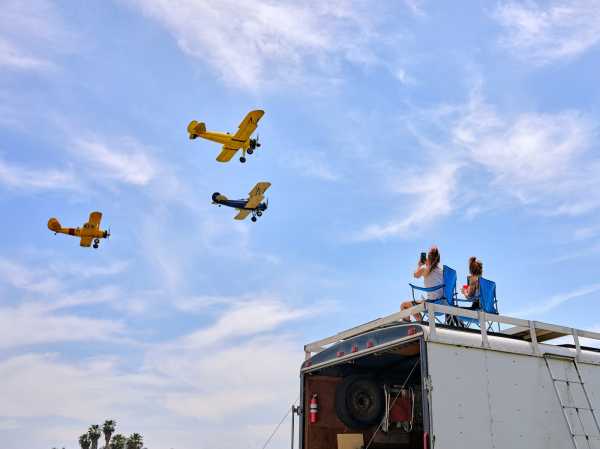
Michael LeAnn, at left, and Shannon Cowe watch as vintage airplanes fly overhead at Flabob Airport.
Robert and Sherry’s friends rallied around him—as Sherry said, “We all love each other. We all help each other out.” Robert’s pit-crew friend put a bag of ice on the fuel line, holding it there. Diana came with her pressure gauge to check Robert’s tires, to make sure they stuck. It was all about the fast start.
Robert won that heat, and they pushed him up the line for the finals, against Hothead Lou. The crowd went still. Robert started fast, the tires gripping and squealing, and kept steady faster down the line—he won by two feet. “He did it!” Sherry said, her face softening from the tense concentration. It’s a race with antique cars, with only a helmet shielding the driver, with capricious engines and tires. She let out a breath and waited for her husband to come back up from the finish line. Robert was exultant. “A back-yard car!” he yelled. “The Little Guys did it!”
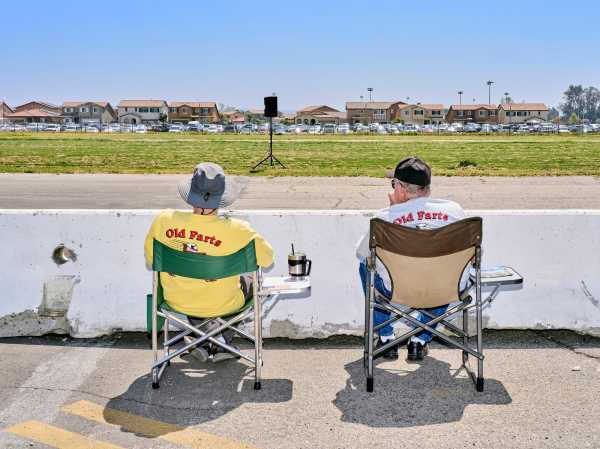
Two spectators sit and watch the races.
Sourse: newyorker.com






